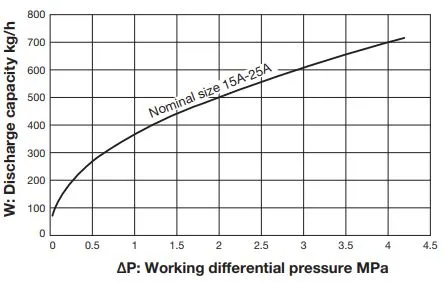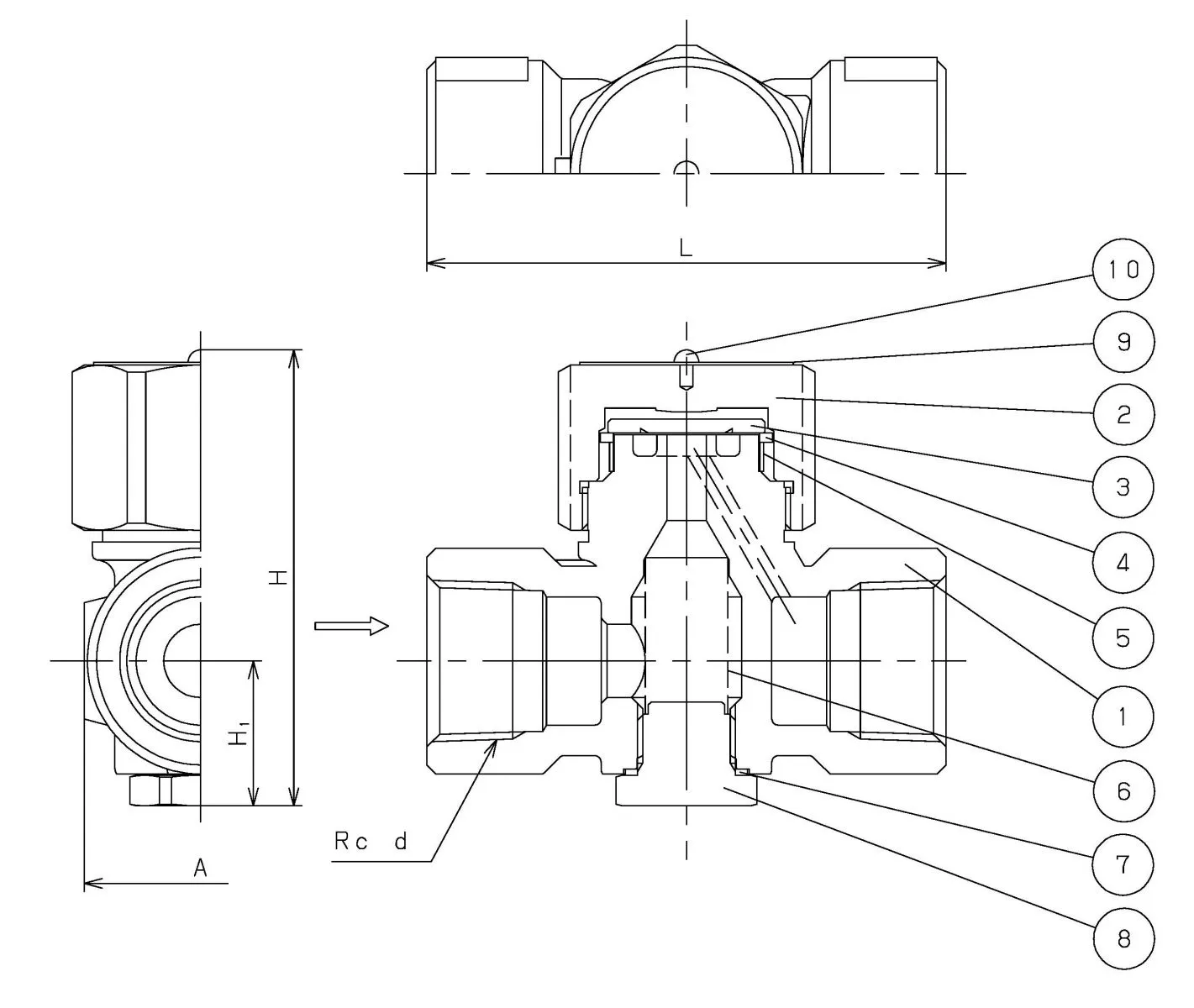Features:
Size 1/2" to 1" BSPT
Body Stainless Steel
Pressure Range 0.35 to 42 BAR
Temperature 0°C to 425°C


| Model | d (BSPT) | L | H | H1 | A |
|---|---|---|---|---|---|
| TSD-42-04 | 1/2" | 78 | 72 | 23 | 32 |
| TSD-42-05 | 3/4" | 85 | 75 | 24 | 38 |
| TSD-42-06 | 1" | 95 | 82 | 27.5 | 45 |
All dimensions in mm unless specified otherwise

| Item | Description | Material | Qty |
|---|---|---|---|
| 1 | Body | Cast Stainless Steel | 1 |
| 2 | Cap B | Stainless Steel | 1 |
| 3 | Disc | Stainless Steel | 1 |
| 4 | Ring | Stainless Steel | 1 |
| 5 | Bi-Metal | - | 1 |
| 6 | Strainer | Stainless Steel | 1 |
| 7 | Gasket | Stainless Steel | 1 |
| 8 | Strainer Cap | Stainless Steel | 1 |
| 9 | Name Plate | Aluminium | 1 |
| 10 | Rivet | Stainless Steel | 1 |
Size 1/2" to 1" BSPT
Body Stainless Steel
Pressure Range 0.35 to 42 BAR
Temperature 0°C to 425°C
What is a Thermodynamic Steam Trap?
A Thermodynamic Steam Trap is an automatic valve, designed to discharge condensate (water) without the loss of live steam. For such a simple, easily maintained, one moving-part, steam trap, its development as a steam trap is steeped in highly technical, highly sophisticated principles. Such as its design and operating characteristics are enabled by the Laws of Physics, Mathematics and Engineering. It functions as a result of utilising the principles of Fluid Dynamics. In Particular (Bernoulli's Principle), which states that an increase in the speed of a fluid occurs simultaneously with a decrease in pressure or a decrease in the fluid's potential energy. The Thermodynamic Steam trap applies the Bernoulli Principle to induce a cycle of operation. That will enable the steam trap to discharge condensate (water) without the loss of live steam.
How does a Thermodynamic Steam Trap work?
The intention of any steam trap is to discharge condensate and hold back steam. To function, Thermodynamic Steam traps utilise the Thermodynamic Characteristics of hot condensate and flash steam . With only one moving part, a hardened stainless steel disc, they give an intermittent blast discharge with clean, tight shut-off (utilising pressure differential between above and below the disc). They are able to withstand superheat, water hammer, corrosive condensate, freezing and vibration. Due to the implementation of a bi metallic strip these traps are also very efficient at the removal of air and other gases from the steam system (especially upon start up, however not all thermodynamic traps have this feature). On start-up, incoming condensate, underpressure, lifts the disc off the seat in the control chamber, and the cool condensate is allowed to move through the trap via an inner ring/groove, and out through the outlet port. Incoming Hot condensate being directed up under the disc through the inlet passage drops in pressure due to increasing velocity. The high velocity creates a low pressure area under the disc, allowing it to move towards the seat. At the same time, flash steam forms as a result of this low pressure and makes its way around and on top of the disc, pressure builds up on the large top surface area of the disc, overcoming any inlet forces. This pressure over-area forces it down against the incoming condensate until it seats. The flash steam is trapped in the chamber above the disc, and the pressure above the disc is greater than the pressure being applied to the underside of the disc. Eventually the trapped pressure above the disc falls as the flash steam condenses. The disc is then raised by the now higher condensate pressure and the cycle starts over.
How long will my Thermodynamic Steam Trap last?
With the ability to operate across their entire working range without any adjustment or change of internals. Thermodynamic Steam Traps are very resilient and generally are a very robust steam trap as they have the ability to withstand extreamley harsh conditions. However it really all depends upon the environment and the quality of the steam that the steam trap operates with. The installation of strainers is highly recommended to reduce the amount of dirt and other impurities from entering the steam trap internals. Most Thermodynamic Steam Traps are available with inbuilt strainer. A correctly selected and sized Steam Trap with a good maintenance regime, should perform for many years. Obviously it should be installed in accordance with the manufacturer's recommendations and it is highly recommended that the regular inspection of the steam trap is carried out at least once a year and if found to be faulty, it should be cleaned and or repaired as required. This will give the valve the best opportunity to continually operate satisfactorily for many years. When a steam trap does fail it can lead to a loss of production and or a waste of energy through leaking steam also fuel bills will increase. Depending on the quality of your steam, It is a rule of thumb that 10/15% of steam traps will fail annually, so it is important that routine checks for correct operation are carried out.
How do I install a Thermodynamic Steam Trap?
It’s important when selecting and sizing any type of steam trap, that certain criteria is met. Such as the operating pressure/temperature, the duty required, the application, back pressure etc. There is no such thing as a universal trap or one size fits all; each trap must be selected to suit the application. Steam Traps should always be installed in accordance with the manufacturers recommendations and in accordance with good steam fitting practice. In Particular always insure; correct direction of flow, correct orientation, leave clear access for general maintenance and repairs. Steam Traps can have various end connections, such as flanged, threaded, socket weld etc so installation will need to take this into account. Always take into consideration the discharge of a steam trap and if it is going to the atmosphere, ensure it is discharging to a safe place, not to cause noise issues, damage to the environment or injury to animals and humans. Where practical, It is highly recommended that all condensate be returned to the boiler due to the high level of energy stored within the hot condensate. Steam condensate is also very clean/pure and will require less chemical treatment, another cost saving reason to return condensate to the boiler system. The Thermodynamic Steam Trap will discharge condensate with an intermittent blast type action. It has a positive discharge, with tight shut-off and will discharge condensate close to steam saturation temperature. The cycle rate of operation depends on the steam temperature and ambient conditions. Most (TD) traps will stay closed for around 20 to 30 seconds. If the trap does open too frequently, due to cold, wet, or windy locations, the rate of opening can be slowed by simply fitting an insulating cover (not normally required if installed suitably). Due to the aggressive blast discharge care must be given to the site of the discharge, especially if to the atmosphere and in close proximity to human trafic. The discharge of the trap also can be noisy and this may restrict the use of thermodynamic traps in certain locations. Outside a hospital ward or operating theatre might not be the best place. The trap should preferably be installed in the horizontal plane but can function acceptably in the vertical plane. Whilst it may be noisy, the noticeable 'clicking sound' which occurs as the trap opens and closes, makes trap testing very easy, as you can hear the distinctive operation.
What are typical uses of a Thermodynamic Steam Trap?
When saturated steam gives up its energy to any colder surface it condenses and condensate is formed. This condensate is usually a hindrance to heat transfer efficiency and a potential danger to the safe operation of any steam system in general. There are many applications for steam traps and many varied reasons why and where a steam trap may be required for any particular application. It is vitally important that those charged with selecting, sizing and installing a steam trap are also very familiar with steam and condensate system design and good steam fitting practice. The results of poor selection and installation can be catastrophic. Property has been damaged and humans have been injured and even killed as a result of poor condensate drainage from a steam system. Typical uses for Thermodynamic Steam Traps are, mains line drainage at regular intervals, all low points in steam systems where condensate can collect, heat tracing applications, platen presses, rotating cylinders etc. If you are unsure please contact us for more detailed sizing and selection support.
How long will my product take to get to me?
This depends upon where you are based and the freight method chosen. If the express freight option is selected it is usually next day delivery to metropolitan areas in Australia for under 5kg. If free freight has been selected it will go by road freight which can be anywhere from 1 to 10 days depending upon your location. It usually averages 3 days.
What warranty do I get?
All of our products come standard with a 12 month warranty. The good news is we have very strict quality controls and all steam traps that leave our warehouse are tested (full material and testing certificates are available) and inspected so there are rarely any issues.

Size 1/2" to 1" BSPT
Body Stainless Steel
Pressure Range 0.35 to 42 BAR
Temperature 0°C to 425°C



| Model | d (BSPT) | L | H | H1 | A |
|---|---|---|---|---|---|
| TSD-42-04 | 1/2" | 78 | 72 | 23 | 32 |
| TSD-42-05 | 3/4" | 85 | 75 | 24 | 38 |
| TSD-42-06 | 1" | 95 | 82 | 27.5 | 45 |
All dimensions in mm unless specified otherwise

| Item | Description | Material | Qty |
|---|---|---|---|
| 1 | Body | Cast Stainless Steel | 1 |
| 2 | Cap B | Stainless Steel | 1 |
| 3 | Disc | Stainless Steel | 1 |
| 4 | Ring | Stainless Steel | 1 |
| 5 | Bi-Metal | - | 1 |
| 6 | Strainer | Stainless Steel | 1 |
| 7 | Gasket | Stainless Steel | 1 |
| 8 | Strainer Cap | Stainless Steel | 1 |
| 9 | Name Plate | Aluminium | 1 |
| 10 | Rivet | Stainless Steel | 1 |